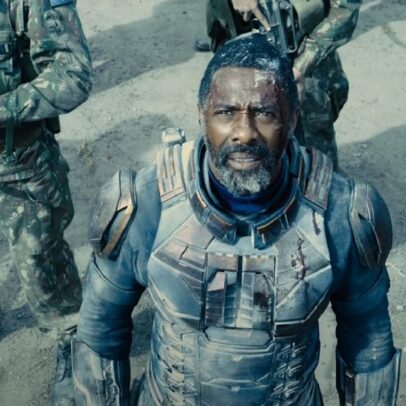It’s been a while since I’ve seen a movie like Baskin. While in small part reminiscent of other genre movies, it contains grotesque imagery that places it above and beyond anything like it. It’s not often that I question a movie going too far, but I frequently would have shut my eyes and plugged my earholes… had I found myself able to look away.
The creative camera work of director Can Evrenol and cinematographer Alp Korfali takes us through rear windows of vehicles and beaded curtains of seedy restaurants into the bowels of Hell… literally, even though they’re later told, “Hell is not a place you go. You carry Hell with you at all times.” Five policemen answer a call for backup, and later learn they’ve been purposely summoned.
The purpose of the men’s sort of “tribunal” in Hell is not clear, but there are enough clues to interpret it in a way that makes sense to you. Baba/The Father (Mehmet Cerrahoglu), a terrifying creation of the filmmakers, spouts possibly meaningful statements about fate and says things like, “You die as you sleep. You resurrect as you wake up,” all the while bathing in the blood of his victims.

Arda (Gorkem Kasal), whose childhood nightmare opens the movie, may be “the chosen one” because of his connection to the afterlife through a pact with a dead friend. Through him we enter various and repeated dream states, not always knowing what is real and what is imagined. Adding emotional depth, his captain, Remzi (Ergun Kuyucu) is his adopted father.
The deserted building that leads the men to Hell was a police station in the Ottoman days, then a stable. In Baskin, it’s a literal house of horrors. Around each corner lie unspeakable terrors such as masked monsters having sex, weird anatomical diagrams on the walls and a mutilated, one-legged person standing in a tub. Chains and hooks swing from the ceiling, clinking together to create an eerie soundtrack.
In a movie with such seemingly unique vision, I am reminded of other horror movies. The bundles of twigs marking the entrance to the building are straight out of The Blair Witch Project, as is a scene where the policemen discover someone standing in a corner in a dark room. Moving through dark halls with flashlights reminds me of REC. And much of the repulsive imagery reminds me of Hellraiser.

The ending has also been done before, although I can’t put my finger on which movie. It’s a twist, yes, but I saw it literally walking down the road. Because of these feelings of familiarity, I’m not sure I can credit Baskin as being an entirely original experience. Just because we’ve never seen a man with his eyes cut out forced to have sex with a goat-woman, doesn’t mean we haven’t seen other parts of the movie.
Neither does it mean that we want
to see it. Any recommendation for Baskin must come with a warning about the graphic visuals. I want to recommend it, but I’m struggling to reconcile my feelings for it. Perhaps a good test for it as a movie would be to imagine it without its gory theatrics… would there be enough remaining to sustain a good movie? I’m not sure that there is.
However, I still want people to see Baskin if they can stomach it. If you can make it through its Hell, it leaves you with something to think about. Maybe it will be the filmmaking itself, or trying to make sense of the story, but it will cause you to think about something. See it with someone else; it’s likely to be divisive, which creates conversation. Maybe that’s its purpose, because not every movie is able to do that.


